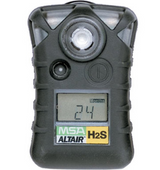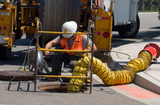Blog
Draeger SCBA Provides Confidence to Confined Space Workers
When the oxygen content drops below 17%, but work has to go on, count on the PAS Lite
SCBA system from Draeger. The PAS Lite is designed not just for breathing in dangerous atmospheres, but also for working in them. The components of the PAS Lite system work seamlessly together for comfort and extreme protection in some of the world's most dangerous work or rescue environments.
The PAS Lite SCBA systems is comprised of a Draeger Panorama Nova P mask, a lung demand valve and hose, a 3
…
Sep 18th 2015
Need a Single Gas Monitor That Displays Constant Gas Levels?
Some folks simply need their single gas monitors to go into alarm if gas concentrations reach dangerous levels. Many companies working with low-level or moderately dangerous environments are simply looking for a device that will allow them to meet minimum OSHA requirements. But for organizations that are serious about gas monitoring, Draeger is already on the radar. PK Safety is pleased to be carrying Draeger gas monitor devices because they have such a consistently good reputation among conf
…
Aug 28th 2015
Draeger Accruo Pump Provides Simple Gas Detection in a Complex World
The
Accuro manual hand pump from Draeger is used in an incredibly wide range of industries for gas detection. Scuba divers use it to test the air from their pumps for carbon monoxide (CO), carbon dioxide (CO2), oil mist, and water vapor. Submariners use it to measure oxygen (O2), carbon dioxide, and hydrogen (both 0-2000 ppm and 0 - 4% LEL).
More often this versatile, non-electric bellows-style pump is used in industrial plants and factories to provide quick, reliable readings of eve
…
Aug 21st 2015
Draeger X-zone 5000 - The Best of Fixed and Portable Gas Monitoring
The
X-zone 5000 from Draeger is designed to get workers out safely in the event of an accident. It combines the best of fixed and portable gas detection technology into a wireless and modular defense system against dangerous gas leaks.
Draeger has been the company that people who are serious about gas detection and safety have turned to for many years. The X-zone 5000 is another in a long line of innovative safety devices that uses cutting edge communications technology combined with
…
Aug 7th 2015
Do I Need a Diffusion or Pump-Style Gas Monitor for My Job?
Deciding which type of gas monitor is right for you is simple if you know what you need the monitor to do. The difference between the two main styles of monitors comes down to the way they sample the air.
At PK Safety, we carry both types. Single gas monitors like the MSA ALTAIR Single-Gas H2S Detector are something you strap to your belt or the front of your shirt and wear with you in areas that may have pockets of hydrogen sulfide. It warns you with beeps, flashing lights, and buzzing if
…
Jul 31st 2015
RAE Systems PID Monitor Used to Check for Ping Pong Dopers
Paddle-gate! The great ping pong doping scandal of the 2012 Olympics. How did we miss this when it happened? The one opportunity for levity in our confined space world? How often does Olympic Ping Pong collide with sophisticated RAE Systems gas detection devices? Not often enough, in our view.
Since the 1970s serious ping pong players have apparently been souping up their paddles to increase performance. Early spin doctors found they could gain more control and even add speed by smearin
…
Jul 17th 2015
Gas Clip Technologies — Innovative Gas Monitoring
Who is Gas Clip Technologies?
Whether you work in oil and gas, utilities, telecommunications, marine, or other demanding industries, you need portable gas detectors that are reliable and durable.
Gas Clip Technologies (GCT), although a relatively young company, started a revolution in the gas monitor industry using quality products with innovative new features. According to users GCT gas monitors are affordable, reliable, and easy to use. However the reason they’ve been adopted so qu
…
Jun 30th 2015
Don't Use Expired Calibration Gas to Test Monitors
Gas produced and put into bottles for bump testing and
calibrating gas monitors has a finite shelf life, and paying attention to that expiration date might save your life. Using expired gas can lead to incorrect calibration of your gas monitor.
Gas concentrations have been known to drop over time. Reactive gases such as hydrogen sulfide react with the material of the cylinder container, and tests have shown some levels to slip from 20 parts per million (ppm) to 6 ppm over a 12-month peri
…
Jun 26th 2015
Confined Space Entry on a Budget
We wanted to take a few minutes to talk about our
Confined Space Entry Contractor’s Kit. This is perfect for folks doing occasional confined space work who don’t want to make a big investment in equipment. The Kit meets all relevant OSHA standards but won’t break the bank.
It comes with a
BW MAX XT II 4-Gas Monitor. It’s one of our best sellers for confined space entry. The MAX XT has an internal pump and a hose attachment that allows you to pull air samples from the space you’re abou
…
May 16th 2015
Gas Sensors: How Do Gas Monitor Sensors Work?
The sensors in your gas monitor work in different ways to keep you safe. Some wear out relatively quickly, while others could conceivably last forever. Here is a very quick overview to help you understand basic gas sensor technology. We hope this information will allow you to see the benefits of regular maintenance, bump testing and
calibration.
The most common sensors used in confined space work are Oxygen, % LEL (Lower Explosive Level), Carbon Monoxide, and Hydrogen Sulfide. Howeve
…
May 2nd 2015











